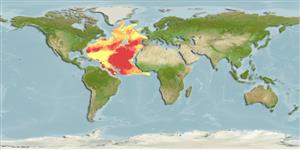Common names from other countries
>
Saccopharyngiformes (Swallowers and gulpers) >
Monognathidae (Onejaws)
Etymology: Monognathus: Greek, monos = one + Greek, gnathos = jaw (Ref. 45335); boehlkei: Named for the late James E. Böhlke in recognition of his valuable contributions to the study of apodal fishes..
More on authors: Bertelsen & Nielsen.
Environment: milieu / climate zone / depth range / distribution range
Ecología
marino batipelágico; rango de profundidad 2500 - 5430 m (Ref. 34506). Deep-water
Atlantic Ocean: the holotype was caught near Bermuda and the paratypes southwest of Madeira.
Tamaño / Peso / Age
Maturity: Lm ? range ? - ? cm
Max length : 7.0 cm TL macho / no sexado; (Ref. 34506)
Short description
Claves de identificación | Morfología | Morfometría
Radios blandos dorsales (total) : 130 - 150; Radios blandos anales: 110 - 130. M. boehlkei differs from all other species of the genus by the high number of anal fin rays (110-130 vs. 42-88) and by an obtuse angle between rostral fang and frontal profile of skull. It is further distinguished by the following combination of characters: head short, snout blunt, skull length4.2-5.2% TL, rostral fang with dorsal profile slightly concave, anal fin origin below dorsal fin rays number 7-13, pectoral fin 2-3% TL, lower jaw nearly straight, and 6 lateral, subdermal spots of pigmentation (Ref. 34506).
All specimens were taken in closing nets, one between 2500 and 3500 m with a bottom depth of 4563 m and the other specimens between 10-3- m above the bottom with soundings from 2960-5430 m (Ref. 34506).
Life cycle and mating behavior
Maturities | Reproducción | Spawnings | Egg(s) | Fecundities | Larva
Bertelsen, E. and J.G. Nielsen, 1987. The deep sea eel family Monognathidae (Pisces, Anguilliformes). Steenstrupia, 13(4):141-198. (Ref. 34506)
IUCN Red List Status (Ref. 130435)
CITES (Ref. 128078)
Not Evaluated
Threat to humans
Harmless
Human uses
Herramientas
Special reports
Download XML
Fuentes de Internet
Estimates based on models
Preferred temperature (Ref.
115969): 2.5 - 2.9, mean 2.7 (based on 105 cells).
Phylogenetic diversity index (Ref.
82804): PD
50 = 0.5001 [Uniqueness, from 0.5 = low to 2.0 = high].
Bayesian length-weight: a=0.00102 (0.00046 - 0.00225), b=3.06 (2.88 - 3.24), in cm Total Length, based on all LWR estimates for this body shape (Ref.
93245).
Nivel trófico (Ref.
69278): 3.6 ±0.59 se; based on food items.
Fishing Vulnerability (Ref.
59153): Low vulnerability (10 of 100).
